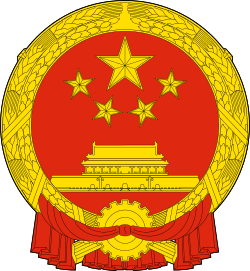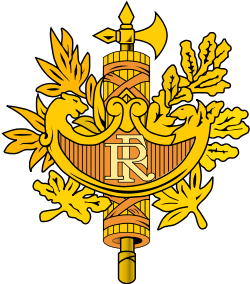China–France relations
 |
|
France |
China |
|---|---|
| China–France relations | |||||||
| Chinese name | |||||||
|---|---|---|---|---|---|---|---|
| Traditional Chinese | 中法關係 | ||||||
| Simplified Chinese | 中法关系 | ||||||
| |||||||
| French name | |||||||
| French | Relations franco-chinoises | ||||||

China–France relations, also known as Sino-French relations or Franco-Chinese relations, refers to the interstate relations between China and France (Kingdom or later).
Note that the meaning of both "China" and "France" as entities has changed throughout history; this article will discuss what was commonly considered 'France' and 'China' at the time of the relationships in question. There have been many political, cultural and economic relationships between the two countries.
History
Medieval
Rabban Bar Sauma from China visited France and met with King Philip IV of France.
William of Rubruck encountered the French silversmith Guillaume Bouchier in the Mongol city Karakorum.
17th and 18th centuries

Numerous French Jesuits were active in China during the 17th and 18th centuries: Nicolas Trigault (1577–1629), Alexander de Rhodes (1591–1660, active in Vietnam), Jean-Baptiste Régis (1663–1738), Jean Denis Attiret (1702–1768), Michel Benoist (1715–1774), Joseph-Marie Amiot (1718–1793).
French Jesuits pressured the French king to send them to China with the aims of counterbalancing the influence of Ottoman Empire in Europe. The Jesuits sent by Louis XIV were: Jean de Fontaney (1643–1710), Joachim Bouvet (1656-1730), Jean-François Gerbillon (1654–1707), Louis Le Comte (1655–1728) and Claude de Visdelou (1656–1737).[1] Returning to France, they noticed the similarity between Louis XIV of France and the Kangxi Emperor of China. Both were said to be servants of God, and to control their respective areas: France being the strongest country of Europe, and China being the strongest power in East Asia. Other biographical factors lead commentators to proclaim that Louis XIV and the Kangxi Emperor were protected by the same angel. (In childhood, they overcame the same illness; both reigned for a long time, with many conquests.)

Under Louis XIV's reign, the work of these French researchers sent by the King had a notable influence on Chinese sciences, but continued to be mere intellectual games, and not tools to improve the power of man over nature. Conversely, Chinese culture and style became fashionable in France, exemplified by the Chinoiserie fashion, and Louis XIV had the Trianon de Porcelaine built in Chinese style in 1670.[2] France became the European center for Chinese porcelains, silks and lacquers and European imitations of these goods.[3]

At the same time, the first ever known Chinese people came to France. Michel Sin arrived in Versaille in 1684 before continuing on to England. More notable was Arcadio Huang, who crossed France in 1702, spent some time in Rome (as a result of the Chinese Rites controversy), and returned to Paris in 1704, where he was the "Chinese interprete of the King" before he died in 1716. He started the first ever Chinese-French dictionary, and a Chinese grammar to help French and European researchers to understand and study Chinese, but died before finishing his work.
In the 18th century, the French Jesuit Michel Benoist, together with Giuseppe Castiglione, helped the Qianlong Emperor build a European-style area in the Old Summer Palace (often associated with European-style palaces built of stone), to satisfy his taste for exotic buildings and objects. Jean Denis Attiret became a painter to the Qianlong Emperor. Joseph-Marie Amiot (1718–1793) also won the confidence of the emperor and spent the remainder of his life in Beijing. He was official translator of Western languages for the emperor, and the spiritual leader of the French mission in Peking.[4]
19th century
From the relatively distant cordiality of the ancien régime, relations between Qing China and France would deteriorate in the European rush for colonies, even as they matured. Nineteenth-century Europe was eager for the acquisition of colonies, and as European opinion of China deteriorated, the once admired empire would become the subject of unequal treaties and colonisation. In 1844, China and France concluded its first modern treaty, the Treaty of Whampoa, which demanded for France the same privileges extended to Britain. In 1860, the Summer Palace was ransacked by Anglo-French units and many precious objects found their way into French museums following this looting. Later, France would seize Guangzhouwan as a treaty port, and take its own concession in the treaty port of Shanghai. Kwangchow Wan, (Guangzhouwan), was leased by China to France for 99 years, according to the Treaty of 12 April 1898, on 27 May as Territoire de Kouang-Tchéou-Wan, to counter the growing commercial power of British Hong Kong[5] and was effectively placed under the authority of the French Resident Superior in Tonkin (itself under the Governor General of French Indochina, also in Hanoi); the French Resident was represented locally by Administrators.[6]
- French Indochina era
- Second Opium War,
- Sino-French War, and French Indochina
- French post offices in China
- Yunnan–Vietnam Railway
20th century
In 1900, France was a major participant in the Eight-Nation Alliance which invaded China to put down the Boxer Rebellion. In the early 20th century Chinese students began to come to France. Li Shizeng, Zhang Renjie, Wu Zhihui, and Cai Yuanpei formed an anarchist group which became the basis for the Diligent Work-Frugal Study Movement. Zhang started an gallery which imported Chinese art, and the dealer C.T. Loo developed his Paris gallery into an international center.
The French Third Republic recognized the establishment of the Republic of China and established diplomatic relations on 7 October 1913. After the outbreak of war, the French government recruited Chinese workers to work in French factories. Li Shizeng and his friends organized the Société Franco-Chinoise d'Education (華法教育會 HuaFa jiaoyuhui) in 1916. Many worker-students who came to France after the war became high level members of the Chinese Communist Party. These included Zhou Enlai and Deng Xiaoping.
During World War II, Free France and China fought as allied powers against the Axis powers of Germany, Italy and Japan.
On 18 August 1945 in Chongqing, while the Japanese were still occupying Kwangchow Wan following the surrender, a French diplomat and Kuo Chang Wu, Vice-Minister of Foreign Affairs of the Republic of China, signed the Convention between the Provisional Government of the French Republic and the National Government of China for the retrocession of the Leased Territory of Kouang-Tchéou-Wan. Almost immediately after the last Japanese occupation troops had left the territory in late September, representatives of the French and the Chinese governments went to Fort-Bayard to proceed to the transfer of authority; the French flag was lowered for the last time on 20 November 1945.[7]
Cold War relations
After the Chinese Civil War (1927–1950) and the establishment of the new communist-led People's Republic of China (PRC) on 1 October 1949, the French Fourth Republic government did not recognize the PRC. Instead, France maintained relations with the Republic of China on Taiwan. However, by 1964 France and the PRC had re-established ambassadorial level diplomatic relations. This was precipitated by Charles de Gaulle's official recognition of the PRC. Before the Chinese Civil War, Deng Xiaoping had completed his studies in Paris prior to ascending to power in China.
Post-Cold War
This state of relations would not last, however. During the 1990s, France and the PRC repeatedly clashed as a result of the PRC's One China Policy. France sold weapons to Taiwan, angering the Beijing government. This resulted in the temporary closure of the French Consulate-General in Guangzhou. France eventually agreed to prohibit local companies from selling arms to Taiwan, and diplomatic relations resumed in 1994.
Since then, the two countries have exchanged a number of state visits. Today, Sino-French relations are primarily economic. Bilateral trade reached new high levels in 2000. Cultural ties between the two countries are less well represented, though France is making an effort to improve this disparity.
2008 rifts
In 2008, Sino-French relations took a downturn in the wake of the 2008 Summer Olympics torch relay. As torchbearers passed through Paris, activists fighting for Tibetan independence and human rights repeatedly attempted to disrupt, hinder or halt the procession.[8] The Chinese government hinted that Sino-French friendship could be affected[9] while Chinese protesters organized boycotts of the French-owned retail chain Carrefour in major Chinese cities including Kunming, Hefei and Wuhan.[10] Hundreds of people also joined anti-French rallies in those cities and Beijing.[11] Both governments attempted to calm relations after the demonstrations. French President Nicolas Sarkozy wrote a letter of support and sympathy to Jin Jing, a Chinese athlete who had carried the Olympic torch.[12] Chinese President Hu Jintao subsequently sent a special envoy to France to help strengthen relations.[13]
However, relations again soured after President Sarkozy met the Dalai Lama in Poland in 2009. Chinese Prime Minister Wen Jiabao omitted France in his tour of Europe in response, his assistant foreign minister saying of the rift "The one who tied the knot should be the one who unties it."[14] French Prime Minister Jean-Pierre Raffarin was quoted in Le Monde as saying that France had no intention of "encourag[ing] Tibetan separatism".[15]
See also
References
- ↑ Eastern Magnificence and European Ingenuity: Clocks of Late Imperial China - p. 182 by Catherine Pagani (2001)
- ↑ Shapely Bodies: The Image of Porcelain in Eighteenth-Century France - p. 44-52 by Christine A. Jones (2013)
- ↑ Lach, Donald F. (June 1942). "China and the Era of the Enlightenment". The Journal of Modern History. University of Chicago Press. 14 (2): 211. JSTOR 1871252. (subscription required (help)).
- ↑ Alain Peyrefitte, Images de l'Empire Immobile, p. 113
- ↑ A. Choveaux, 1925, pp. 74–77
- ↑ Olson 1991: 349
- ↑ Matot, p. 214-217.
- ↑ "China condemns Olympic torch disruptions" Archived April 12, 2008, at the Wayback Machine., France 24, April 8, 2008
- ↑ "Raidissement des relations sino-françaises", Radio France Internationale, April 15, 2008
- ↑ "National flag of France with Hakenkreuz added by Chinese protesters" (in French). Reuters. 2008-04-19. Retrieved 2008-04-19.
- ↑ "Anti-French rallies across China", BBC, April 19, 2008
- ↑ "«Chère mademoiselle Jin Jing, je voudrais vous dire toute mon émotion...»", Libération, April 28, 2008
- ↑ "La porte-parole du ministère des AE appelle aux efforts conjoints de la Chine et de la France pour promouvoir les relations bilatérales", The People's Daily, April 23, 2008
- ↑ "China ready to mend ties if France moves first", AFP, January 22, 2009
- ↑ "'Encore du travail' pour des retrouvailles entre Pékin et Paris (Raffarin)", Le Monde, February 10, 2009
References
- The China Quarterly, 169, Cambridge University Press, 2002, pp. 33–44, doi:10.1017/S0009443902000049
Further reading
- France/China: intercultural imaginings by Alex Hughes (2007)

